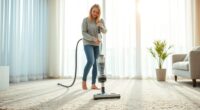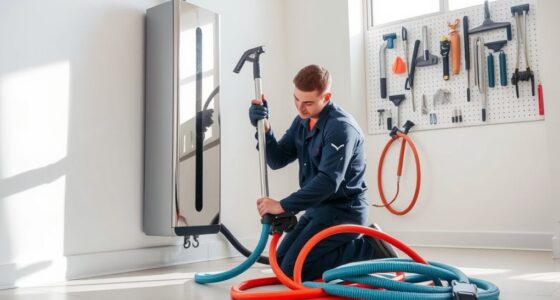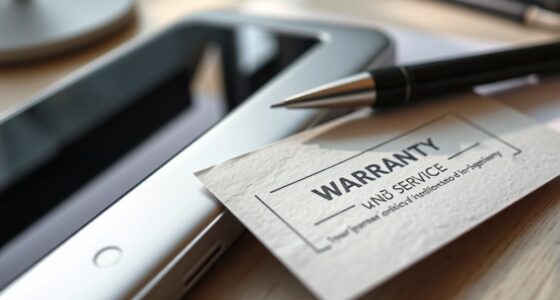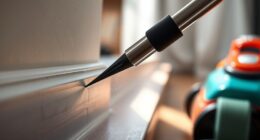To calibrate your vacuum’s brush height for perfect pickup, turn off and unplug the machine first. Locate the adjustment mechanism near the brush roll, usually a dial or lever, and set it according to your floor type—lower for carpets and closer to the surface, higher for hard floors. Make sure the brush spins freely without hitting the floor. Double-check alignment and test on a small area; for more detailed tips, keep exploring further.
Key Takeaways
- Turn off and unplug the vacuum before adjusting the brush height to ensure safety.
- Locate the height adjustment mechanism, typically a dial or lever near the brush roll.
- Set the brush closer for thick carpets and higher for hard floors or low-pile carpets.
- Confirm the brush spins freely without hitting the floor or feeling loose after adjustment.
- Test the vacuum on a small area to ensure optimal dirt pickup and proper brush contact.
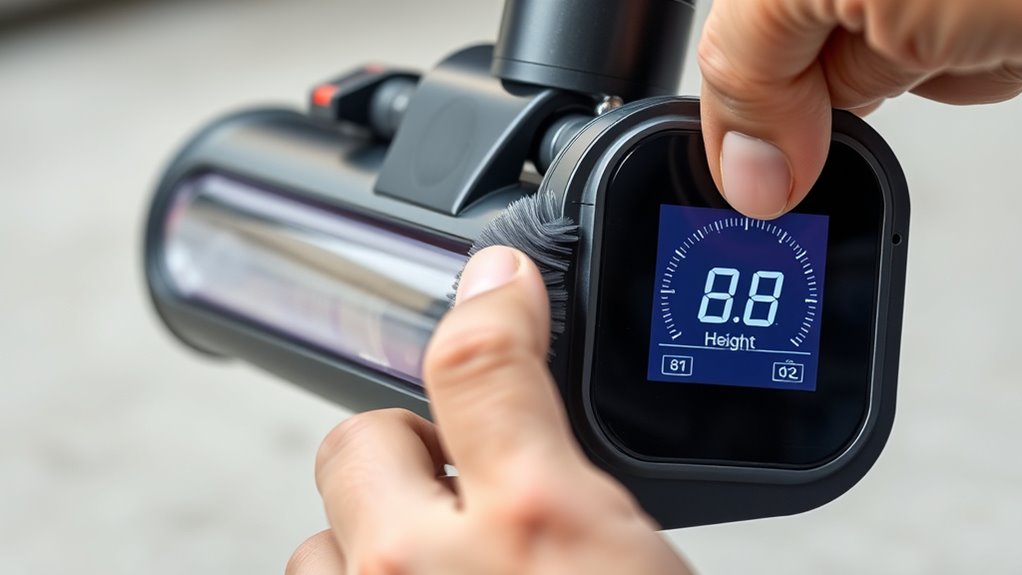
Maintaining the ideal brush height on your vacuum is essential for effective cleaning and device longevity. When you properly perform a brush adjustment, you ensure that the brush roll makes excellent contact with various surfaces, whether you’re cleaning carpets or hard floors. Correctly calibrated brush height helps you pick up dirt efficiently and prevents unnecessary wear on both the brush and the vacuum itself. Additionally, some models include tuning options that can be adjusted to optimize performance further, especially for different floor types.
Start by inspecting your vacuum’s brush height adjustment mechanism, which can usually be found near the brush roll or on the side of the cleaner. Some models have a simple dial or lever that allows you to change the height, while others might require more detailed steps. Before making any adjustments, turn off and unplug your vacuum to avoid accidents. Once safe, check the manufacturer’s guidelines for your specific model, as they often specify recommended settings for different floor types.
Inspect and adjust your vacuum’s brush height mechanism safely before cleaning different floor types.
When adjusting, consider your carpet compatibility. Thicker, high-pile carpets need the brush to be closer to the surface to effectively loosen and lift debris. Conversely, on hard floors or low-pile carpets, you want the brush slightly elevated to prevent scratching or scattering dirt rather than collecting it. To determine the right position, place the vacuum on the surface you’re cleaning and observe the brush roll. It should spin freely without hitting the floor or being too loose to make contact.
If your vacuum’s brush adjustment isn’t straightforward or if you notice uneven cleaning, it’s worth double-checking the alignment. Proper alignment ensures the brush is evenly set and that the height is consistent across its width. When you make a brush adjustment, always test your vacuum on a small area first. Watch how the brush interacts with the surface—if it’s too high, dirt may not get lifted; if it’s too low, it could cause strain on the motor or damage the carpet fibers.
Frequently Asked Questions
Can Brush Height Calibration Be Automated?
Yes, brush height calibration can be automated. With advanced sensor technology, your vacuum can automatically adjust the brush height for ideal pickup. These sensors detect surface type and debris, sending signals to the device to fine-tune the brush height in real-time. This automation ensures consistent cleaning performance without manual adjustments, making your vacuum smarter and more efficient while saving you time and effort.
How Often Should I Recalibrate My Vacuum’s Brush?
You should recalibrate your vacuum’s brush based on brush wear and manufacturer guidelines, typically every few months or when you notice a drop in cleaning performance. Regular recalibration ensures maximum pickup and prevents damage. Keep an eye on wear signs, and follow your vacuum’s specific instructions. Recalibrating when needed helps maintain efficiency, prolongs the brush’s life, and keeps your floors thoroughly clean.
Will Changing Brush Height Affect Battery Life?
Think of your vacuum’s brush like a race car’s tire; changing the height affects its performance. Adjusting it properly helps maintain ideal vacuum efficiency but can impact the brush lifespan if set too low. A correct height reduces strain on the motor and preserves battery life. When you maximize the brush height, you ensure cleaner floors and longer-lasting components, keeping your vacuum running smoothly and efficiently.
Is Calibration Different for Hardwood vs. Carpet?
You’ll find that calibration varies for hardwood and carpet due to flooring compatibility. For hardwood, you want a lower brush height to prevent scratches and guarantee gentle cleaning. For carpet, a higher setting helps the brush dig in for better pickup. Adjust the brush height accordingly, keeping in mind your flooring type, so you optimize cleaning performance without damaging your surfaces. Proper calibration ensures your vacuum works efficiently across different flooring types.
What Tools Are Needed for Manual Calibration?
Imagine you’re in a 1950s workshop—your tools are your trusty allies. For manual calibration, you’ll need a screwdriver, a ruler or gauge, and perhaps a level. These tools help with precise brush adjustment and tool selection, ensuring your vacuum’s brush height is just right. Use the screwdriver to tighten or loosen parts, and the ruler to measure clearance. With these, you can fine-tune your vacuum for ideal pickup on different surfaces.
Conclusion
Think of your vacuum’s brush as a faithful steed, perfectly saddled for the journey. When you calibrate the height just right, it gallops smoothly over carpets, picking up every speck. Too high, and it’s like riding with the saddle loose—missed spots. Too low, and it’s like dragging a heavy load. Find that sweet spot, and your vacuum will glide effortlessly, transforming your cleaning into a graceful dance of efficiency.

